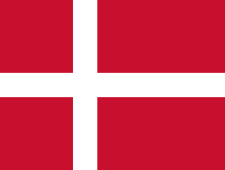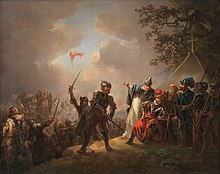丹麥國旗
旗帜
丹麥國旗,又稱為丹尼布洛(丹麥語:Dannebrog),意思為「丹麥人的旗」或「紅色的旗」。丹麥的國旗是現今使用的國旗中最古老的,自1219年使用至今。
 | |
| 用途 | 民用旗(海陸) |
|---|---|
| 比例 | 28:37 |
| 啟用日期 | 1854年啟用 1893年5月1日正式訂定 |
| 形式 | 紅底白十字 |

自14世紀以來,丹麥君主就開始使用一面繪有白底紅十字的旗幟。[1]一個對丹麥國家史學影響深遠的起源傳說將這面旗幟的引入與1219年的林達尼斯戰役聯繫在一起。[2]
細長的北歐十字架代表代表基督教,反映了它在 18 世紀被用作航海旗幟。[3]這面旗幟在16世紀初開始作為國旗流行起來。1834年,私人使用國旗被宣布為非法,但在1854年的一項規定中再次被允許。這面旗幟保持着吉尼斯世界紀錄,即自1625年以來一直是世界上使用時間最長的國旗。[4]
丹麥國旗對北歐國家的北歐十字國旗設計起了重大影響。其他採取類似國旗設計的國家就包括了瑞典、挪威、芬蘭、冰島和法羅群島,以及不列顛群島設得蘭群島和奧克尼群島。
-
王室旗
比例: 56:107
設計
編輯| 顏色標準 | 紅 | 白 |
|---|---|---|
| Pantone | 186C | |
| 網頁顏色標準 | #C8102E | #FFFFFF |
| RGB | 200-016-046 | 255-255-255 |
歷史旗幟
編輯參見
編輯- ^ "Dannebrog" by Hans Christian Bjerg, p.12, ISBN 87-7739-906-4.
- ^ Andrew Evans. Iceland. Bradt. 2008 [2007-12-31]. ISBN 9781841622156.
Legend states that a red cloth with the white cross simply fell from the sky in the middle of the 13th-century Battle of Valdemar, after which the Danes were victorious. As a badge of divine right, Denmark flew its cross in the other Scandinavian countries it ruled and as each nation gained independence, they incorporated the Christian symbol.
Inge Adriansen, Nationale symboler, Museum Tusculanum Press, 2003, p. 129: "Fra begyndelsen af 1400-tallet kan Dannebrog med sikkerhed dokumenteres som rigsflag, det vil sige statsmagtens og kongens flag" (English: "Dannebrog can with certainty be documented as flag of the realm, that is the flag of the authority of state and of the king, from the beginning of the 1400s") - ^ 中世紀帶有十字的旗幟可以追溯到十字軍東征,後來被用來代表聖徒(如聖喬治十字旗),十字代表基督教
Jeroen Temperman. State Religion Relationships and Human Rights Law. Martinus Nijhoff Publishers. 2010 [2007-12-31]. ISBN 978-9004181489.
許多以基督教為主的國家的國旗上都印有十字架,象徵着基督教。北歐國家——丹麥、芬蘭、冰島、挪威和瑞典——國旗上的斯堪的納維亞十字或北歐十字也代表基督教。
。細長的十字圖案隨後被其他北歐國家採用:瑞典、挪威、芬蘭、冰島和法羅群島,以及不列顛群島設得蘭群島和奧克尼群島。 - ^ Oldest continuously used national flag. Guinness World Records. [2023-11-10].


